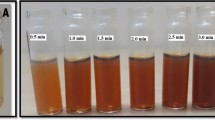Abstract
We report the use of novel silver nanoparticle-immobilized halloysite nanotube (AgNP–HNT) composites to determine their ability to detect DNA damage. Naturally occurring tubular structures such as HNTs act as support matrices for the formation of AgNPs in the presence of neem broth as reducing agent and silver nitrate (AgNO3) as precursor. The tubular structure of halloysite nanotubes allowed the AgNP formation on their surface to derive AgNP–HNT composites. These AgNP–HNT composites were characterized by using scanning electron microscopy, energy-dispersive analysis attachment (energy-dispersive X-ray fluorescence), and differential scanning calorimetry (DSC). We further confirmed the DNA binding capacity of AgNP–HNT composites by DSC and further characterized their role in sensing DNA damage. Here, we have demonstrated the difference in electrostatic properties of single- and double-stranded oligonucleotides (ss-DNA and ds-DNA) with AgNP–HNT composites using spectrophotometry and spectrofluorometry. We observed that as the binding of ds-DNA or ss-DNA with silver nanoparticles increased, there was a concurrent increase in the absorption which was characterized with the decrease in fluorescence intensities. Our studies show the possibility of using this AgNP–HNT composite not only for enhancement of the shelf life of AgNPs but also to give an edge to use this technology for many biological and medical applications





Similar content being viewed by others
References
Rosi, N. L., & Mirkin, C. A. (2005). Nanostructures in biodiagnostics. Chemical Reviews, 105, 1547–1562.
Giljohann, D. A., Seferos, D. S., Daniel, W. L., Massich, M. D., Patel, P. C., Mirkin, C. A. (2010). Gold nanoparticles for biology and medicine. Angewandte Chemie International Edition, 49(19), 3280–3294.
Eugenii, K., Willner, I. (2004). Integrated nanoparticle—biomolecule hybrid systems: synthesis, properties, and applications. Angewandte Chemie International Edition, 43, 6042–6108.
Zhao, W., Brook, M. A., Li, Y. (2008). Design of gold nanoparticle-based colorimetric biosensing assays. Chembiochem, 9(15), 2363–2371.
Wang, H., Yang, R., Yang, L., Tan, W. (2009). Nucleic acid conjugated nanomaterials for enhanced molecular recognition. ACS Nano, 3(9), 245–2460.
Rawtani, D., & Agrawal, Y. K. (2012). Multifarious applications of halloysite nano tubes: a review. Reviews on Advanced Materials Science, 30(3), 282–295.
Rawtani, D., & Agrawal, Y. K. (2012). Study the behaviour of HNT with DNA intercalator acridine orange. BioNanoScience. doi:10.1007/s12668-012-0066-1.
Huixiang, L., & Lewis, R. (2004). Colorimetric detection of DNA sequences based on electrostatic interactions with unmodified gold nanoparticles. PNAS, 10(39), 14036–14039.
Wang, Z. D., Zhang, J. Q., Ekman, J. M., Kenis, P. J., Lu, Y. (2010). DNA-mediated control of metal nanoparticle shape: one-pot synthesis and cellular uptake of highly stable and functional gold nanoflowers. Nano Letters, 10, 1886–1891.
Ahmad, M. B., Shameli, K., Yunus, W., Ibrahim, N. A., Darroudi, M. (2010). Synthesis and characterization of silver/clay/starch bionanocomposites by green method. Australian Journal of Basic and Applied Sciences, 4(7), 2158–2165.
Dong, R. X., Chou, C. C., Lin, J. J. (2009). Synthesis of immobilized silver nanoparticles on ionic silicate clay and observed low-temperature melting. Journal of Materials Chemistry, 19, 2184–2188.
Zhang, X., Mark, R., Liu, J. (2012). Surface science of DNA adsorption onto citrate-capped gold nanoparticles. Langmuir, 28, 3896–3902.
Xu, L., Zhu, Y., Ma, W., Chen, W., Liu, L., Kuang, H., Wang, L., Xu, C. J. (2011). New synthesis strategy for DNA functional gold nanoparticles. Journal of Physical Chemistry C, 115, 3243–3249.
Mady, M. M., Mohammed, W. A., EI-Guendy, N. M., Elsayed, A. A. (2011). Interaction of DNA and polyethylenimine: Fourier-transform infrared (FTIR) and differential scanning calorimetry (DSC) studies. International Journal of Physical Sciences, 6(3), 7328–7334.
Author information
Authors and Affiliations
Corresponding author
Rights and permissions
About this article
Cite this article
Rawtani, D., Agrawal, Y.K. & Prajapati, P. Interaction Behavior of DNA with Halloysite Nanotube–Silver Nanoparticle-Based Composite. BioNanoSci. 3, 73–78 (2013). https://doi.org/10.1007/s12668-012-0071-4
Published:
Issue Date:
DOI: https://doi.org/10.1007/s12668-012-0071-4




